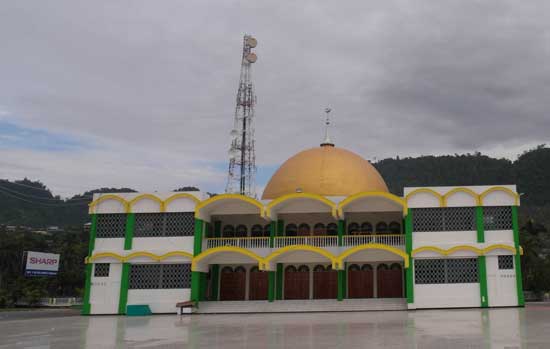Tag Archives: Religion
Indonesia’s gone Gaga: Lessons in democracy
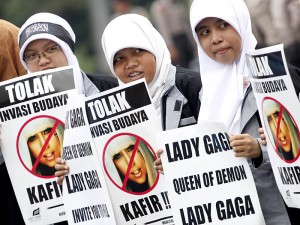
I don’t like going to the dentist; I’m capable of inventing all sorts of the-dog-ate-my-homework excuses for my inevitable last-minute foot-dragging. But as is so often the case, Indonesia’s reality outstrips my imagination. As I rocked up late for my regular check-up yesterday, I was able to lay the blame at the Satanically clad feet of Lady Gaga. My path to dental hygiene was blocked by Islamic groups trying to keep her out of the homeland. They included this group of young women, dressed in fashions imported wholesale from Saudi Arabia, waving posters saying: “Reject Cultural Invasion!”. No comment.
The Gaga Saga has been running for a while. Essentially, a minority of noisy radicals in Jakarta’s largely Moslem population think that Lady Gaga is the Devil. She promotes homosexuality and general licenciousness, apparently, and as for her backing dancers, well… Student groups, the good gentlemen of the FPI (the Islamic Defenders’ Front) and even some conservative Christians have been demonstrating against the concert, planned for June 6th. The police, widely accused for years now of fainting whenever the FPI sneezes, has shilly-shallied about whether to issue a permit for the concert. They’ve said they will if the Minstry of Religious Affairs and the Indonesian Council of Ulemas issue permits first. As if Lady Gaga were a bag of chips that needed to be certified as Halal.
Lots of people would like to big this up as another indication that Radical Islam is tightening its grip on Indonesia. I rather think it indicates exactly the reverse. Moderate Muslim groups as well as Gaga fans have added to Jakarta’s traffic jams with their own protests, underlining the importance of religious freedom in Indonesia. Bali has offered to host the concert. And the generally sensible Minstry of Tourism and Creative Industries has said the concert should go ahead.
Yes, militant Moslems shout disproportionately loudly in the public sphere in Indonesia. They probably get their way disproportionately frequently in consequence. But how does that differ from the disproportionate influence of militant Christians in the United States? Terrorising providers of reproductive health services in Tennessee is to my mind rather more damaging than terrorising providers of sexually inclusive pop lyrics in Jakarta. Indeed the Defenders of Gaga in Indonesia have been more vocal than the defenders of a woman’s right to reproductive self-determination in many parts of the States.
To my mind, Saga Gaga is a mark of how remarkably robust Indonesia’s democracy is [or maybe it isn’t: see UPDATE, below]. It is a reminder, also, of how very obtuse people can be when they prioritise the letter of the religious law over the principles that guide the faith. Without wishing to overstate her cultural importance, I think it is fair to say that Lady Gaga is a powerful advocate for inclusiveness. That seems to me entirely consistent with the core principles of most major religions, which acknowledge human frailty and try to address it with compassion. The thugs who would oppose Lady Gaga in the name of religion undermine that core. According to the Jakarta Globe, the FPI was handing out leaflets saying “Let’s crush liberals! Let’s fight gays and lesbians!”. Inclusiveness is not in their vocabulary. As for compassion…
The thugs are stupid at a more basic level, too; no promoter could hope to scrape up the publicity that they are providing for free. Indeed they’ve gone even further; they are underwriting her tour. FPI leaders proudly report that they have bought over a hundred tickets to see the show, should it go ahead. Not, you understand, because they are interested in seeing the Diva strut her stuff, but so that they can protect other concert goers from the damage that watching her might do. As I write, the fate of the concert is undecided. but I hope it goes ahead. I’m trying to imagine what someone as creative as Gaga could do with a set of stage costumes based on the burka.
***UPDATE***
On 27th of May, Gaga’s management said they would cancel the concert, because they didn’t want any harm to come to The Lady or her fans. I would not have predicted this; it makes me sick to my stomach for all the obvious reasons.
Aceh’s new leaders: Militantly religious?
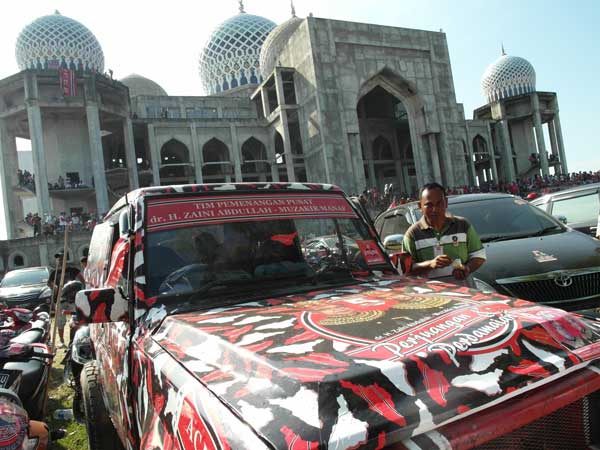
Well it’s official. The Partai Aceh candidates for Governor and Vice Governor will rule Indonesia’s most fractious province for the next five years. Their election campaign was a strange mix of proto-militarism and religious fervour. At every rally, hundreds of the young men who are the party’s most fanatical supporters stood in serried ranks in red, black and white “camouflage” uniforms, saluting the candidates, one of whom is a rather homey doctor who has spent most of his adult life in Sweden. They (and I) listened also to sermons about how Partai Aceh would keep the province free of “kaffir” religions — anything that is not Islam, effectively. There were strange digressions about protecting the territory from the Jews, although to my knowledge the Jewish community is, uuuum, somewhat under-represented in Indonesia as a whole, let alone in Aceh.
As he formally acknowledged his election, the doctor from Sweden, Zaini Abdullah, said he would seek to implement a “purer” form of Islamic Sharia law. His bitter rival in this election, former governor Irwandi, is seen by some to have sold out because he refused to sign a bill implementing Sharia law, finding some if its provisions too harsh. Stoning adulterers to death, for example. I’ll be interested to see how Zaini Abdullah negotiates this one. His running mate, the former guerilla commander Muzakir Manaf (who looks like he’s been sent over to Party headquarters by Central Casting), is widely known to have at least five wives. That’s one more than is allowed by Sharia law (which, says Zaini, “is about how to educate our youths about what is right and wrong”). Technically, then, the Vice Governor is an adulterer. Will Partai Aceh’s dedication to purity put it’s own number two at risk of death? Watch this space.
Taking tea with the dead. Again.
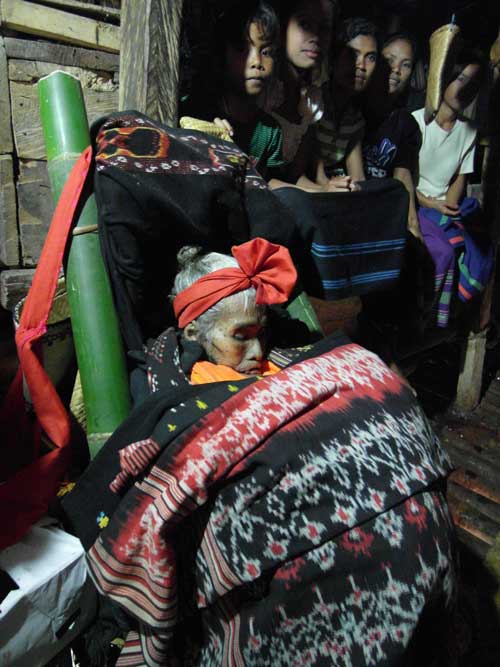
“Taking Tea with the Dead” — the working title of the book I’m not quite getting around to writing — was taken from an experience over 20 years ago, when I was invited in to meet the grandmother of some random villager in Sumba. I was a little put out, on being introduced to Granny, to find that she had died the day before. I picked this piece of exotica as my working title because I was pretty sure that I would find, revisiting these parts two decades later, that such esoteric traditions would have disappeared. Tea with the Dead would surely have died, swept out of Indonesia on a homogenising wave of modernisation. The title would reflect the changes in the country, and perhaps, in a self-centred sort of way, my nostalgia for something that was no more.
Not at all. When I went to visit my friend Mama Bobo the other day to arrange our outing to the pasola jousting, she was in a tizz. Her sister-in-law had died the night before. Now she had to scrape together weavings, pigs, buffalo and endless supplies of betel nut to contribute to the week of feasting that precedes the funeral. Of course I must come along (this would entail some scraping together of my own, for every guest must pay tribute). And so, 22 years after I first took tea with a dead Granny, I repeated the ritual. Which rather calls in to question that homogenising wave of modernisation. Though Granny slept through it, the remainder of her terrestrial existence was quite bloody. For the less squeamish readers there will be more, much more, in the book. Whatever it is called.
Headhunters stand up against religious thuggery
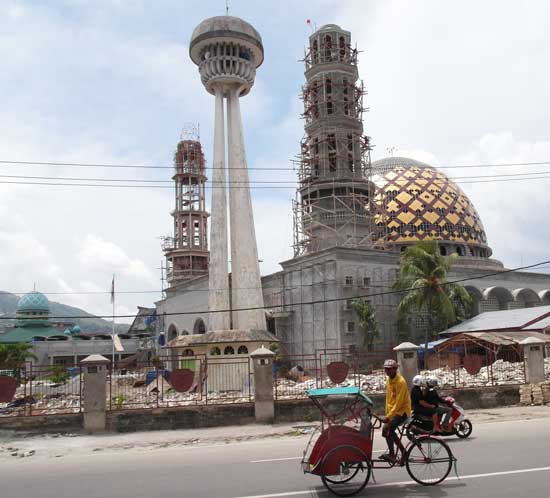
One of the mysteries of life in Indonesia is how the government and the security forces allow absolute chaos, sometimes even mass murder, to develop in totally predictable ways. As groups such as the Islamic Defenders Front (Front Pembela Islam or FPI in Indonesian) move around the country beating up hookers and inciting violence against non-Moslems, the President and his ministers play Three Monkeys — see no evil, hear no evil, and therefore never have to speak about any evil. Their dereliction of duty is such that the Dayak tribe in Kalimantan has finally taken matters into its own hands, taking over the airport’s runway to prevent FPI leaders getting off a plane to sow their poison. (As an aside, the manager of a large nightclub in north Jakarta told me a while ago that she pays the FPI substantial “protection” money.They’ve exchanged their leather jackets for white robes, she said, but it’s the same old thugs.)
Lest we forget: way back in 1999, thousands of frenzied young men from the overcrowded Islamic heartland of East Java shipped out to predominantly Christian Ambon to support their brothers in a largely trumped-up fight about supposed religious insults. This group, known as Laskar Jihad, something of a sister organisation to FPI, did not hide their intentions and they apparently didn’t need to; some of the boatloads of rabid jihadis were waved off by government ministers keen to boost their ratings with Moslem voters. The result was a three year pogrom which spread across the eastern province of Maluku, in which 9,000 people are thought to have died. Communities were torn apart, previously mixed areas were taken over by a single religious group, and the was a spate of symbolic dick-wagging, expressed mostly through religious architecture, that persists to this day. The photo above is of a gargantuan mosque being built in the very heart of formerly Christian Ambon; huge churches are springing too, though only in subsections of the city where Christians have kept their strongholds.
The conflict in Maluku was shut down after 9/11, as international tolerance for religious (and particularly Islamic) extremism fell well below zero. This rather suggests that if the security forces did want to prevent these conflicts, which tend to be massively lucrative for the police and the army, they could. And indeed there’s some evidence that their swift action when I was in the region in November/December pre-empted a potentially bloody Christmas. But the scars of the conflict in Maluku are still deeply felt. Kalimantan, too, has its scars; at about the time Laskar Jihad was wreaking havoc in Maluku, the Dyaks, a tribe known in part for their propensity to cut the heads off their enemies, were in bloody battle with settlers from Madura. Their refusal to host the bigwigs of FPI suggests they’d like to pre-empt more unnecessary conflict. FPI is not Laskar Jihad — the latter supposedly disbanded after the Bali bombings in 2002. But its leaders were inciting FPI members to violent action in Maluku as recently as last September. “We’ve issued an edict to all FPI members throughout the nation to get ready to leave for Ambon to defend Moslems” the FPI’s Secretary General Muhammad Shabri Lubishe told the Voice of al-Islam website. (The story rated 236 Facebook “Likes”.)
Some commentators see the Dayak’s action as a turning point in Indonesia’s tolerance for groups that provoke violence. I’m not so sure. When the middle class intellectuals of Jakarta drew strength from the Dayaks and staged a protest against FPI in central Jakarta, the police turned pussy. They asked protesters to disband because they had reports that FPI were on the way and they couldn’t guarantee the safety of protesters. The response of Indonesia’s spineless president, Susilo Bambang Yudhoyono is even less encouraging. “Why should others be allowed to carry out their activities while our brothers in the FPI are forbidden?,” he asked journalists at a press conference. Because it’s a thuggish organisation which burns down buildings and injures and kills individuals to stop them doing completely legal things such as selling alcohol and running nightclubs, perhaps?
Equal Opportunity Kitsch
For the last few weeks, I’ve been in Maluku, formerly known as the Moluccas, famous for spices and inter-religious carnage. The hideous religious riots of 1999-2002 have left a deep scar on this part of the country. Whole communities were uprooted and there was a shift between islands as people who formerly lived perfectly happily with neighbours of another faith consolidated into single-faith blocks.
Needless to say, this makes me furious. I have never understood how people can grow to hate someone else because of who they choose to pray to, any more than I can understand hatred based on who people choose to sleep with. In the spirit of conciliation, therefore, I’m posting evidence that all religions in Maluku are equally adept at really kitsch religious art.
The Moslems in Banda Neira give us these Id-ul-Fitri wishes, complete with Arab style mosque and a Reggae Che Guevarra.
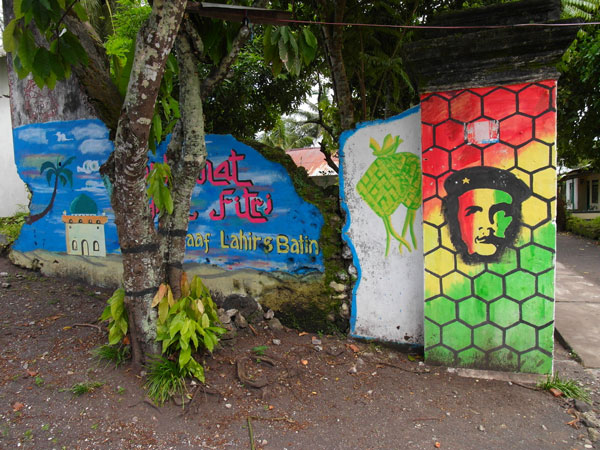
At the Chinese cemetery, also in Banda Neira, we have a breastfeeding lion standing guard over the graves.
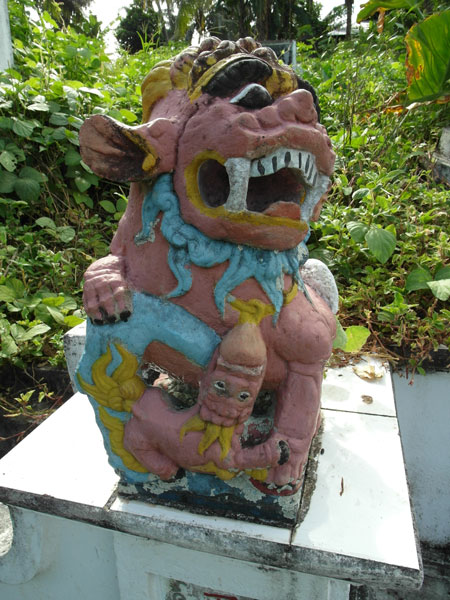
Further south in Saumlaki, in the Tanombar islands, virtually every house has some icon or other to offer to the competition. This Jesus Sneezed fresco caught my eye.
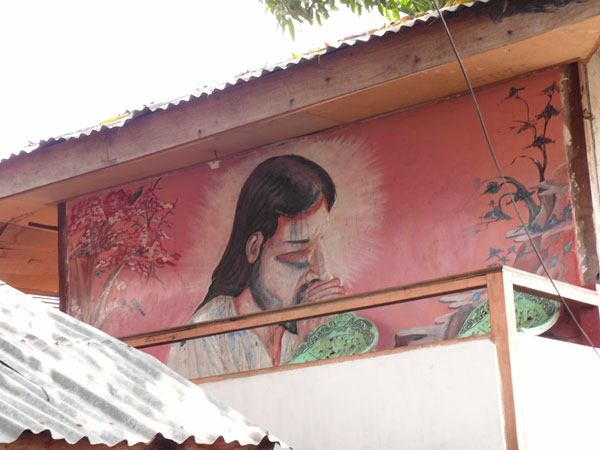
I am sad to say that the Protestants have done less to defend their title to kitsch, and I have little to offer on that score. At the risk of being accused of bias, I do think Maluku’s Catholics have made a more than adequate contribution that perhaps makes up for the slackness of the other Christians. This larger-than-lifesized statue commemorating the first Catholic baptisms of head-hunting “savages” in Tanimbar takes some beating.
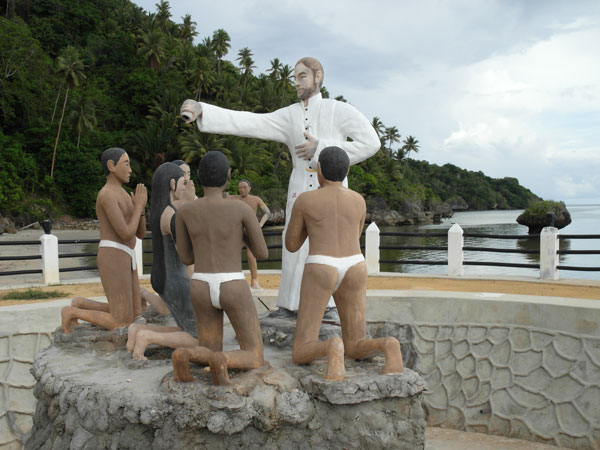
Graffiti, Catholic style
The Blessed Virgin Mary on a hill going out of Boawae, in Flores, made me homesick for the near-identical BVM outside the Priest’s House in Castletownshend, the prettiest village in Ireland. (I wonder idly where they are produced. There’s a smaller but otherwise also identical version in the garden of the guest house I’m staying in.) As I walked up to photograph her, this graffiti outside the dorm rooms caught my eye. I wasn’t sure whether to be shocked that it was there at all, or to be shocked by how tame it is…
Death to the budget! Graves in Sumba
Sumba is a graveyard of bodies and good intentions. Physically, it is littered with impressive megalithic tombs and their hideous modern counterparts. Financially, it is littered with development projects that haven’t quite developed anything.
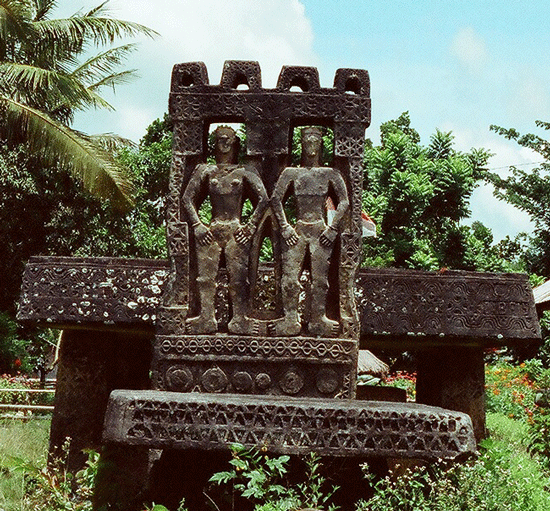
“Megalithic” sounds ancient, and many are, but they are still being built today. The tomb in the photo above was built in the 1970s; it took several hundred people the best part of a year to drag the stones on wooden rollers from the quarry to the burial site, and months more to carve. It’s “voluntary” work, but workers need to be fed, and richly. That makes for a lot of dead buffalo. No huge surprise that many people are now using cement and tiles. Since the tile-piles have doors in them (to make it easier to shove family members in as they die) the island looks increasingly like a repository for surplus public loos, though some families are prettying them up (and covering their bets) with pictures of Jesus.
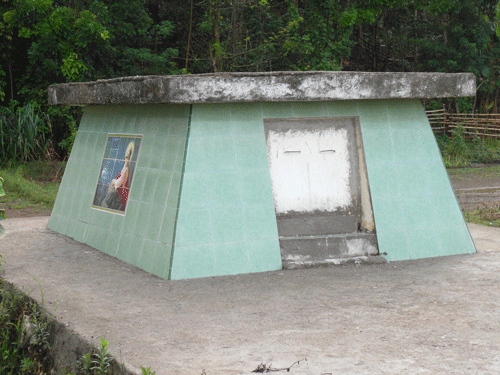
Not wanting to be outdone, the island’s Christians Proper (often ethnic Chinese) have got Public Works to weigh in with cement. The Christian graveyard has a lovely new fence, in a delicate shade of primrose. Its cement pillars are carefully placed so that any Indonesian child and most adults can walk comfortably between them. And it cost this district, which scores close to the bottom of the national ranking on education and health, just 314 million rupiah (a cool US$ 30,000). This certainly doesn’t compare with the cost of a traditional West Sumba tomb, but still…
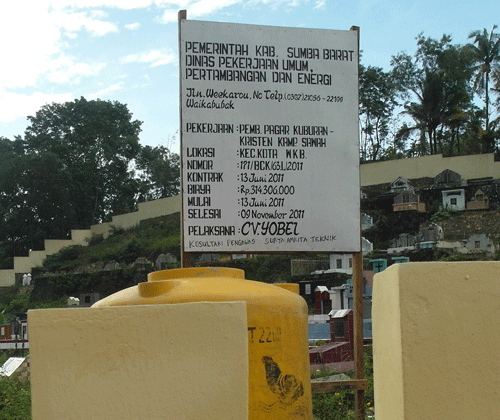
May everyone rest in peace.
